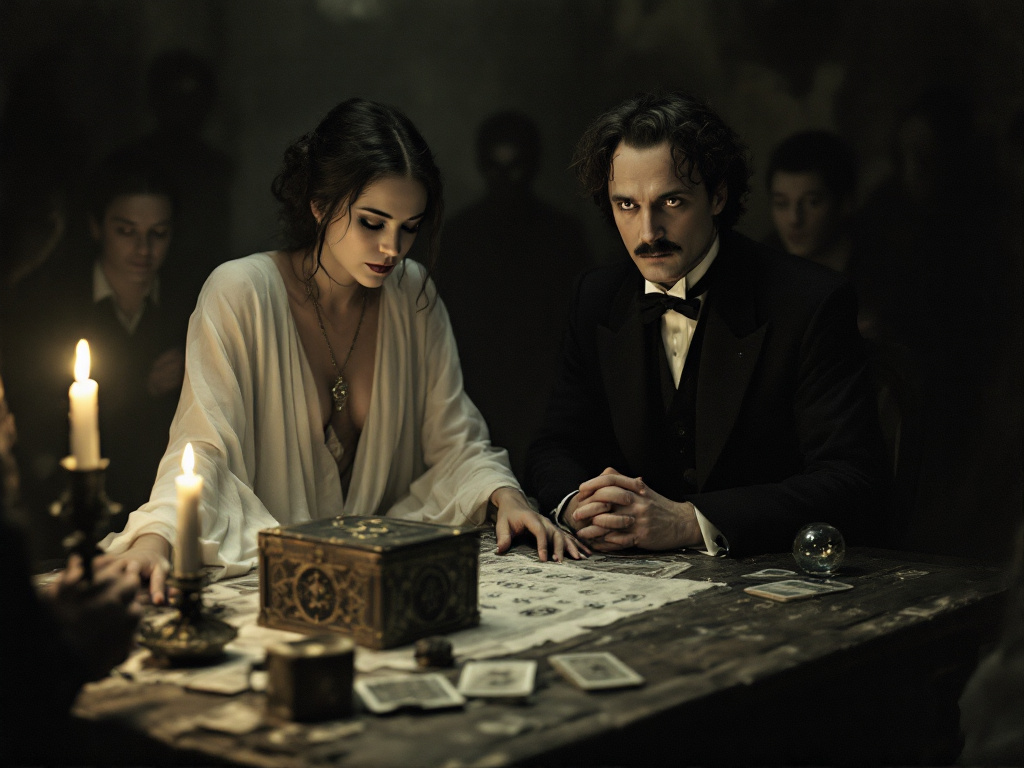The Extraordinary Rise of Houdini
Harry Houdini, born Erik Weisz in 1874 in Hungary, became the most famous illusionist and escapologist of his time. Emigrating to the United States as a child, he quickly developed a passion for magic and sleight of hand, perfecting escape acts that turned him into a living legend. His escapes from handcuffs, chains, straitjackets, and water-immersed boxes left audiences breathless, solidifying his status as an entertainment icon.
The Hunter of Fake Mediums
 Beyond his talent in illusionism, Houdini was a fierce opponent of spiritualism. In the early 20th century, séances and mediums claiming to communicate with the dead were widely popular. However, Houdini considered these practices fraudulent and actively worked to expose them. Using his knowledge of stage magic and deception techniques, he demonstrated how many mediums used illusions to deceive the public.
Beyond his talent in illusionism, Houdini was a fierce opponent of spiritualism. In the early 20th century, séances and mediums claiming to communicate with the dead were widely popular. However, Houdini considered these practices fraudulent and actively worked to expose them. Using his knowledge of stage magic and deception techniques, he demonstrated how many mediums used illusions to deceive the public.
He was part of a scientific committee alongside Arthur Conan Doyle, who firmly believed in spiritism. Their relationship deteriorated when Houdini repeatedly debunked supposed evidence of communication with the afterlife. This battle against frauds led Houdini to hold public lectures and publish books, including A Magician Among the Spirits.
The Margery Case: His Most Famous Exposure
One of Houdini's most renowned cases of debunking involved the medium Mina Crandon, known as Margery. In the 1920s, Scientific American offered a $2,500 prize to anyone who could demonstrate genuine paranormal abilities, and Margery was a contestant. During her séances, she claimed to summon the spirit of her deceased brother, Walter, producing inexplicable phenomena such as table levitations, mysterious sounds, and moving objects.
the 1920s, Scientific American offered a $2,500 prize to anyone who could demonstrate genuine paranormal abilities, and Margery was a contestant. During her séances, she claimed to summon the spirit of her deceased brother, Walter, producing inexplicable phenomena such as table levitations, mysterious sounds, and moving objects.
Houdini, invited as an investigator, carefully observed Margery's methods and uncovered numerous tricks. He noticed, for instance, that the medium was able to ring a bell inside a sealed box using her feet, after feeling them brush against his legs. To prevent her from using her lower limbs, Houdini designed a special box that restrained her body while leaving only her head and arms free, limiting her movements. However, some spirit manifestations continued to occur, raising suspicions of external assistance.
Another of Houdini's experiments involved sealing Margery’s hands with wax to prevent any hidden manipulations. Despite this, the paranormal activity persisted, suggesting that the medium had found a way to bypass the restrictions. Houdini also discovered that an "ectoplasmic hand" appearing during a séance was nothing more than a piece of artificial skin hidden by the medium. Additionally, he identified hidden mechanisms in the room that enabled the movement of objects without any supernatural intervention.
In the end, thanks to his observations, Houdini demonstrated that Margery had no supernatural powers, and the prize was never awarded to her. This episode further cemented Houdini's reputation as the greatest debunker of fake mediums of his era.

Mina Crandon Fake Ectoplasm Hand
His Obsession with Death and the Final Experiment
Houdini was not just a fraud-hunter; he was obsessed with the idea of death and the possibility of communicating from beyond the grave. Before he died, he established a secret code with his wife, Bess: if it were possible to communicate after death, he would do so using that code. Every year, for ten years after his passing, Bess held a séance to see if Houdini would send a message. No communication ever occurred.
His Escape Techniques: A Contribution to Security
Houdini's incredible skills were not limited to entertainment. His escape techniques from ropes, chains, and locks influenced even law enforcement and military training. He demonstrated how criminals could escape from poorly designed handcuffs or prison cells, leading to improvements in security systems. Additionally, during World War I, he taught Allied soldiers escape tactics in case they were captured by the enemy.
The Mystery of His Death
Houdini died on October 31, 1926, Halloween, from peritonitis caused by appendicitis. However, the circumstances of his death led to many theories. A few days prior, a student named J. Gordon Whitehead challenged him to prove his abdominal strength, striking him multiple times in the stomach. Some believe these blows worsened a pre-existing condition, ultimately leading to his death. Others speculate that he was poisoned by spiritualist groups angered by his campaign against them.
Contrary to popular belief, Houdini did not die during a failed water escape. This is a myth likely stemming from his famous "Chinese Water Torture Cell" act, in which he was suspended upside down in a water-filled tank. Houdini always managed to escape from his performances, and his death was not due to a stage accident but to medical complications.
An Eternal Legacy
Houdini remains one of the most fascinating figures in entertainment history. His fight against frauds, his genius in illusionism, and the mystery surrounding his death continue to fuel his legend. Even today, his name is synonymous with magic, mystery, and unparalleled ingenuity.








Leave a Comment